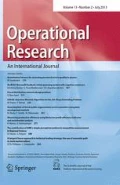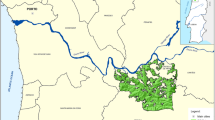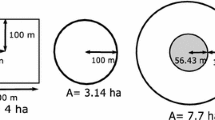Abstract
The integrated harvest-scheduling model addresses the tactical forest management planning problem of maximizing harvest revenues minus road construction and transportation costs. This paper considers the problem of developing innovations to this model such that it can: (1) be used to generate solutions to problem instances containing a large set of candidate roads, with many circuits; (2) yield improved solutions when compared to prior formulations; and (3) achieve improvements in the solutions by reducing the total construction and transportation costs. To the end, a new formulation of the integrated model was developed using the following strategy: (a) each candidate road was represented in the model by two directed arcs (instead of one undirected edge, as used in prior formulations); and (b) a set of strengthening constraints including clique constraint was developed to exploit the property of the directness of the candidate roads. The new model was tested and compared with prior formulations on eight problem instances, ranging in size from 900 to 4900 stands and containing candidate roads ranging in number from 3424 to 19,184. Results show that the new formulation: (1) entails the use of larger set of constraints than prior formulations; (2) produced tighter root-LP gaps, than prior models, as the problem instances grew in size and complexity; and (3) produced solutions with the tightest relative gap, the highest objective function value, and major reductions in the cost of constructing a road network, as the problem instances grew in size and complexity. Our conclusion is that the strategy of formulating the integrated model, used in this paper, may be useful to future researchers and practitioners working on this problem.





Similar content being viewed by others
References
Akay AE, Aruga K, Bettinger P, Sessions J (2013) Using optimization techniques in designing forest roads and road networks. Bartın Orman Fakültesi Dergisi 15(1):49–62
Andalaft N, Andalaft P, Guignard M, Magendzo A, Wainer A, Weintraub A (2003) A problem of forest harvesting and road building solved through model strengthening and Lagrangean relaxation. Oper Res 51(4):613–628
Anderson AE, Nelson J (2004) Projecting vector-based road networks with a shortest path algorithm. Can J Forest Res 34:1444–1457
Arabatzis G, Petridis K, Galatsidas S, Ioannou K (2013) A demand scenario based fuelwood supply chain: a conceptual model. Renew Sustain Energy Rev 25:687–697
Armstrong GW (2014) Considerations for boreal mixedwood silviculture: a view from the dismal science. Forest Chron 90:44–49
Beaudoin D, LeBel L, Frayret JM (2006) Tactical supply chain planning in the forest products industry through optimization and scenario-based analysis. Can J Forest Res 37(1):128–140
Bjørndal T, Herrero I, Newman A, Romero C, Weintraub A (2012) Operations research in the natural resource industry. Int Trans Oper Res 19(1–2):39–62
Carlsson D, Rönnqvist M (2005) Supply chain management in forestry–case studies at Södra Cell AB. Eur J Oper Res 163(3):589–616
Chung W, Sessions J (2003) NETWORK 2000: a program for optimizing large fixed and variable cost transportation problems. In: Arthaud GJ, Barrett TM (eds) Proceedings of the 8th symposium on systems analysis in forest resources, 27–30 September 2000, Snowmass Village, Colorado. Kluwer Academic Publishers, Dordrecht, The Netherlands, pp 109–120
Clark MM, Meller RD, McDonald TP (2000) A three-stage heuristic for harvest scheduling with access road network development. Forest Sci 46(2):204–218
Crowe K, Nelson JD, Boyland M (2003) Solving the area-restricted harvest-scheduling model using the branch and bound algorithm. Can J Forest Res 33:1804–1814
Dijkstra EW (1959) A note on two problems in connection with graphs. Num. Math 1:269–271
Goycoolea M, Murray A, Vielma JP, Weintraub A (2009) Evaluating approaches for solving the area restriction model in harvest scheduling. Forest Sci 55(2):149–165
Guignard M, Ryu C, Spielberg K (1998) Model tightening for integrated timber harvest and transportation planning. Eur J Oper Res 111:448–460
Jones JG, Hyde JFC, Meacham ML (1986) Four analytical approaches for integrating land management and transportation planning on forest lands. Res. Pap. INT-36 l, USDA Forest Service, Intermountain Res. Sta. 32 pp
Kirby MW, Wong P, Hager WA, Huddleston ME (1980) Guide to the integrated resources planning model. Technical Report, Berkeley
Kirby MW, Hager WA, Wong P (1986) Simultaneous planning of wildland management and transportation alternatives. TIMS Stud Manag Sci 21:371–387
Klotz E, Newman AM (2013) Practical guidelines for solving difficult mixed integer linear programs. Surv Oper Res Manag Sci 18(1):18–32
Magnanti TL, Wong RT (1984) Network design and transportation planning: models and algorithms. Transp Sci 18(1):1–55
Martin JA (1971) The relative importance of factors that determine log-hauling costs. USDA Forest Service Research Paper NE-197. Northeastern Forest Experimental Station, Upper Darby
McDill ME, Rebain SA, Braze J (2002) Harvest scheduling with area-based adjacency constraints. Forest Sci 48(4):631–642
Murray AT (1999) Spatial restrictions in harvest scheduling. Forest Sci 45(1):45–52
Murray AT, Church RL (1995) Heuristic solution approaches to operational forest planning problems. OR-Spektrum 17:193–203
Natural Resources Canada. 2017. Current lumber, pulp and panel prices. http://www.nrcan.gc.ca/forests/industry/current-prices/13309. Accessed 15 Sept 2017
Nelson J, Brodie JD (1990) Comparison of a random search algorithm and mixed integer programming for solving area-based forest plans. Can J Forest Res 20:934–942
Reeves CR (1993) Modern heuristic techniques for combinatorial optimization. Alfred Waller Ltd, Henley-on -Thames
Richards EW, Gunn EA (2000) A model and tabu search method to optimize stand harvest and road construction schedules. Forest Sci 46(2):188–203
Richards EW, Gunn EA (2003) Tabu search design for difficult forest management optimization problems. Can J For Res 33:1126–1133
Shan Y, Bettinger P, Cieszewski CJ, Li RT (2009) Trends in spatial forest planning. Math Comp For Nat Resour Sci 1(2):86–112
Shirasawa H, Hasegawa H (2014) A comparative study of heuristic algorithms for the multiple target access problem. J Forest Res 19(5):437–449
Silva MG, Weintraub A, Romero C, De la Maza C (2010) Forest harvesting and environmental protection based on the goal programming approach. Forest Sci 56(5):460–472
Veliz FB, Watson J-P, Weintraub A, Wets R-B, Woodruff DL (2015) Stochastic optimization models in forest planning: a progressive hedging solution approach. Ann Oper Res 232(1):259–274
Weintraub A, Navon D (1976) A forest management planning model integrating silvicultural and transportation activities. Manag Sci 22:1299–1309
Weintraub A, Jones G, Magendzo A, Meacham M, Kirby M (1994) A heuristic system to solve mixed integer forest planning models. Oper Res 42:1010–1024
Weintraub A, Jones G, Meacham M, Magendzo A, Magendzo A, Malchuk D (1995) Heuristic procedures for solving mixed-integer harvest scheduling-transportation planning models. Can J For Res 25:1618–1626
Acknowledgements
This research was funded by an NSERC Strategic Network grant on Value Chain Optimization. We also thank Waqas Ghouri, Timber Pricing Specialist and Tom Harries, Forest Industry Liaison Officer, from the Ontario Ministry of Natural Resources and Forestry (OMNRF) for sharing information about the parameters required to examine our model for this paper.
Author information
Authors and Affiliations
Corresponding author
Rights and permissions
About this article
Cite this article
Naderializadeh, N., Crowe, K.A. Formulating the integrated forest harvest-scheduling model to reduce the cost of the road-networks. Oper Res Int J 20, 2283–2306 (2020). https://doi.org/10.1007/s12351-018-0410-5
Received:
Revised:
Accepted:
Published:
Issue Date:
DOI: https://doi.org/10.1007/s12351-018-0410-5




